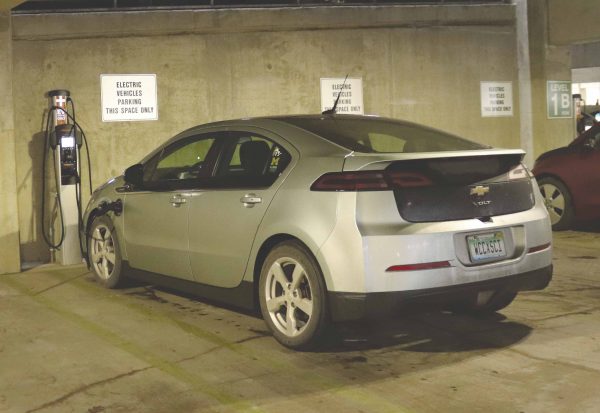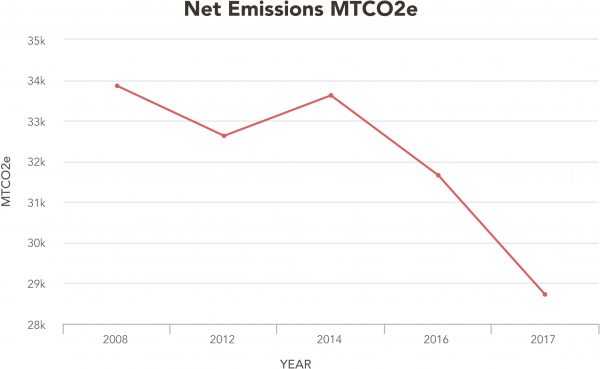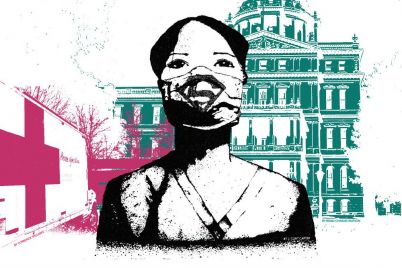- Electric car chargers inside parking structure support cleaner energy. Josh Mehay | Washtenaw Voice
- Since 2014, emissions have decreased by 15% on campus. Projected to decrease to 20% by 2020. Courtesy of SecondNature.org
By Danny Villalobos
Staff Writer
WCC’s Sustainability Council is working on a new plan to accelerate its goal for a carbon-zero college.
“I would like to see a speed-up of the carbon-zero deadline,” said Dale Petty, a full-time professor, a member of the Sustainability Council and the college’s liaison to guide toward the goals in the 2014 WCC Climate Action and Sustainability Plan.
“We have to figure out how to use less electricity or use cleaner electricity,” Petty said.
WCC’s current plan is to have a carbon-zero campus by 2060, along with a 2 percent decrease in carbon emissions each year. The plan is required to be updated every four years. The new developing plan will be presented to the Board of Trustees in May.
Formed in 2014, the Sustainability Council consists of representatives from Facilities, Student Development and Activities, administration, faculty and students. The council’s primary goal is implementing the WCC Climate Action and Sustainability Plan.
Many energy-saving solutions are already in place on campus:
Older light bulbs are being replaced with more energy efficient ones
Occupancy detectors are in place across campus to turn off lights when rooms are vacant
the HVAC fan system run times have been slowed-down.
Commuting is one way of reducing the school’s carbon footprint. Since the number of electric vehicles on the road has increased, WCC provides electric car chargers in the parking structure. Additionally, the energy that DTE provides for WCC uses natural gas instead of coal.
“It isn’t wonderful, but it leaves a lower carbon footprint, which lowers our emissions,” said Petty.
A report from Second Nature, an organization that collects data on the college’s path toward carbon-zero emissions, shows the college’s decrease in its net emissions since 2008. The total has dropped by over 15 percent since 2008, which is exactly what the 2014 plan proposed.
Other efforts in reducing the college’s carbon footprint involve exterior lighting to be installed with LED light bulbs, according to Bill Ghrist, manager of Energy and Systems Integration at the college, and a member of the Sustainability Council.
LED lights have also been installed on the north side of the TI building, along with the first floor of the Student Center.
“All new projects will also have LED lights installed as well,” Ghrist said.
Ghrist serves as an adviser for the council. His role is to determine the most practical solutions for WCC. As the manager of Energy and Systems Integration, Ghrist is also tasked with keeping the college’s energy consumption as low as possible.
“We already warmed the planet by 1 degree Celsius,” said Smita Malpani, a full-time environmental science professor at WCC, who also is also a member of the council. “We are already living some of these catastrophes, [such as] wildfires in California, but they will become much worse as early as 2040.”
Malpani’s task is to help integrate sustainability throughout the curriculum.
A half-degree Celsius difference does not seem like a big difference on paper, but Malpani suggests otherwise.
According to Malpani, even a 1.5- to 2-degree Celsius difference can have devastating effects.
“With 1.5 degrees warming, we will lose most of our coral reefs. With 2 degrees warming, we will lose all coral reefs forever — and all the food security and tourism economies that go with them,” Malpani said.
The Sustainability Council hopes to start a conversation about campus sustainability. Faculty, staff and students are welcomed to contribute any ideas, suggestions or concerns to the council.



